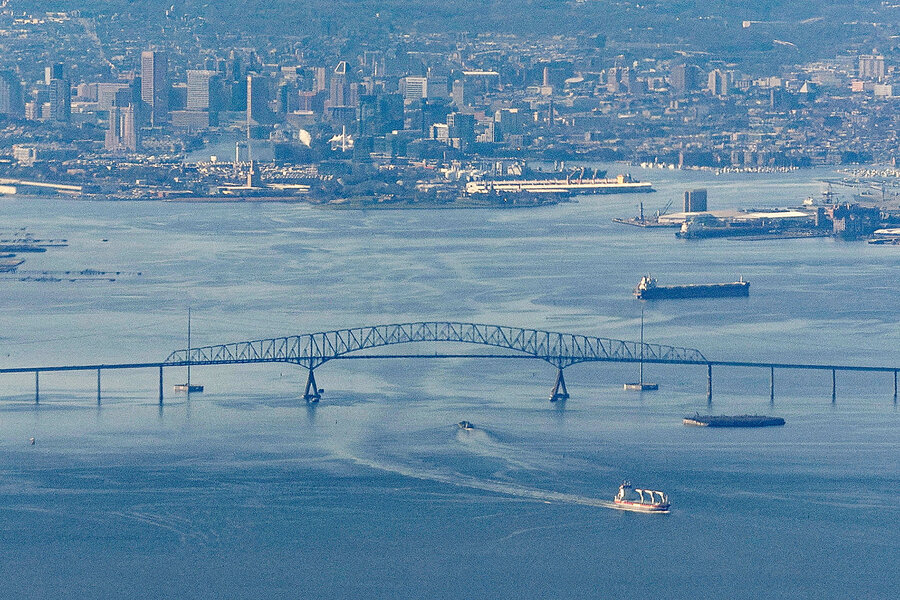Key Bridge is gone. It leaves a hole in Baltimore’s blue-collar soul.
Loading...
| Baltimore
“Key Bridge is gone!” my wife said.
She looked at her phone as we lay in bed in the early hours Tuesday. Across Baltimore others were waking up the same way, incredulous. It was not just the dimensions of the collapse, though that was bad enough. To many residents of the Queen City of the Patapsco River, it was also the particular landmark involved.
Why We Wrote This
Before it collapsed, the Francis Scott Key Bridge in Baltimore was a city icon. You could see it from everywhere. It had a personality – like the city and those who worked on it.
Baltimore loves its historical artifacts, and Key Bridge was – is – one. You saw it all the time from neighborhoods all over. Arched and boxed in steel, the main span was not so much beautiful as confident. It looked like a bridge that knew its business and didn’t want any fuss. Its ethos was blue-collar, like the city.
Perhaps it is sadly fitting that the fatal casualties of the bridge collapse were construction workers just doing their job, filling potholes on the roadbed.
Besides its place in the landscape, the bridge is famous for its connection to Francis Scott Key, author of the lyrics to “The Star-Spangled Banner.” (Local traffic reporters sometimes called it the “car-strangled spanner.”)
Rebuilding the bridge will be neither quick, easy, nor cheap. But Baltimore, for all its many real problems, is a city that keeps grinding ahead.
“Key Bridge is gone!” my wife said.
She looked at her phone as we lay in bed in the early hours Tuesday. Across Baltimore, others were waking up the same way, incredulous. It was not just the dimensions of the collapse, though that was bad enough. To many residents of the Queen City of the Patapsco River, it was also the particular landmark involved.
Baltimore loves its historical artifacts, and the Key Bridge was – is – one.
Why We Wrote This
Before it collapsed, the Francis Scott Key Bridge in Baltimore was a city icon. You could see it from everywhere. It had a personality – like the city and those who worked on it.
You saw it all the time from neighborhoods all over. You’d drive around City College in the northeast stretches of the city, and there it was, glimmering in the distance. You’d park at Johns Hopkins across town, and suddenly it was right there. You’d walk down to the sea wall at Fort McHenry, and it was close enough to count vehicles crossing.
Arched and boxed in steel, the main span was not so much beautiful as confident. It looked like a bridge that knew its business and didn’t want any fuss. Its ethos was blue-collar, like the city. Indeed, the fatal casualties of the bridge collapse were construction workers just doing their job, filling potholes on the roadbed.
Key Bridge was not the crossing you used if you were driving through from Virginia on your way to New York. It was on the side of the Baltimore beltway where container ships dock and semitrailers rumble up to deliver to warehouses.
Its north landing curled around the site of the former Sparrows Point steel complex, once the largest refinery in the world and a key World War II shipyard. The site was declining but still large when the bridge opened in 1977.
Now the crumpled structure lies across the Patapsco River outlet, blocking egress from the point like a kicked-over toy.
“This is an unspeakable tragedy,” Baltimore Mayor Brandon Scott, a lifelong city resident, told CNN. “When you ... live in Baltimore, this bridge is iconic.”
Besides its place in the landscape, the bridge is famous in Baltimore for its connection to Francis Scott Key, author of the lyrics to “The Star-Spangled Banner.” (Local traffic reporters sometimes referred to it as the “car-strangled spanner.”)
As many news reports have noted in recent days, the bridge is located near the spot where Key, detained on a British warship, watched the British bombard Fort McHenry during the Battle of Baltimore on Sept. 13, 1814.
But as many Baltimoreans also know, that spot is physically marked for much of the year with one of America’s most unusual patriotic memorials, the “Star-Spangled Banner” memorial buoy. This floating marker, painted to resemble a U.S. flag, was visible from part of the bridge’s span.
The Coast Guard removes the buoy in the fall each year for storage and maintenance, and then sets it again in late spring.
Will locals ever again see the buoy’s starry flash as they drive south over the bridge? Will a bridge as appealing and, yes, iconic as the old Key Bridge ever again grace workaday Baltimore?
President Joe Biden has said that the federal government will pay the entire cost of the reconstruction. Congress would have a say in that, however, and costs could be considerable. The process could be slow. Transportation Secretary Pete Buttigieg warned on Wednesday that rebuilding the bridge will be neither quick, easy, nor cheap.
But Baltimore, for all its many real problems, is a city that keeps grinding ahead. The old Memorial Stadium is now a YMCA, but Ravens stadium and the Orioles’ Camden Yards are new downtown icons. Three years ago, the beloved neon Domino Sugar sign, a harbor companion to Key Bridge, went dark – to be replaced months later by a modern LED reconstruction.
“If you’re a betting person, don’t bet against Baltimore,” Mayor Scott told CNN. “We will build back better and stronger, and together.”








